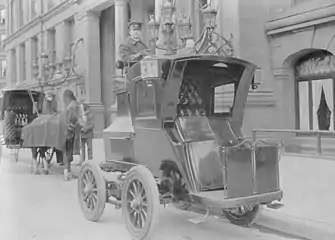Electric Vehicle Company
Electric Vehicle Company was an American holding company that operated from 1897 to 1907 and was an early manufacturer of battery-powered automobiles.
 Electric Vehicle Co. Hansom Cab, ca. 1904 | |
| Industry | Automotive, Patent holding company |
|---|---|
| Predecessors |
|
| Founded | September 27, 1897 in New York City |
| Founders | Isaac Rice |
| Defunct | 1907 |
| Fate | Bankrupted |
| Headquarters | New York City |
Key people |
|
| Products | Electric cars, Selden Patent |
| Brands | |
| Owners | |
.tif.jpg.webp)
History
The Electric Vehicle Company was founded September 27, 1897, as a holding company of battery-powered electric vehicle manufacturers acquired and assembled by Isaac Rice.[1][2]
In May 1897, Rice had acquired the Electric Carriage & Wagon Company (E.C.W.C.), a New York manufacturer of electric taxicabs. Its cabs were built by Henry G. Morris and Pedro G. Salom, who had created the Electrobats, the country's first useful electric automobiles.[3] E.V.W.C. leased, rather than sold, its vehicles, and built service stations for repairs and to quickly change out battery sets. In January 1897, 12 of the cabs were in use in Manhattan.
After the merger, E.V.C. concentrated on building heavy but reliable electric cabs in the E.C.W.C. workshops, and it also operated the rental system for a short time.[1] By 1899, E.V.C. had built several hundred vehicles[4] and become the country's leading motor car manufacturer.[5]
Electric Vehicle was taken over in 1899 by a syndicate of William C. Whitney, Thomas Fortune Ryan, Anthony N. Brady, and P. A. B. Widener. Their "Lead Cab Trust" aimed to develop a monopoly by placing electric cabs on the streets of major American cities, starting with New York City, Philadelphia, Chicago, Washington, D.C., and Boston. The company ultimately sold some 2,000 cars, but this was not enough to establish monopoly. It fell into hard times in 1900 as gasoline-powered automobiles emerged, lawsuits attacked their monopolistic practices, and scandal surrounded the poor performance of its vehicles. Oldsmobile displaced EVC as the top U.S. automaker in 1901.
Whitney brought in industrial leader Albert Augustus Pope, who brought the Columbia Automobile Company. The trust was reorganized as the parent company of several vehicle manufacturers, among them Columbia and the Riker Electric Vehicle Company, which was acquired in 1902.
Electric Vehicle's chief asset was now the holding of the Selden Patent, which established a right to royalties from all manufacturers of internal combustion engine vehicles. While this was initially lucrative, it drew lawsuits and other opposition from other manufacturers.
The company declared bankruptcy in 1907. The patent remained valid until 1913, but lost its worth when the appellation court held that it only applied to vehicles with Brayton engines, of which none existed.
See also
Notes
- Kimes/Clark: Standard Catalogue of American Cars 1805–1942 (1996), p. 525
- "The Columbia Car: Reliable, Simple to Operate and Ready for Action". secondchancegarage.com. Archived from the original on 16 December 2013. Retrieved 16 December 2013.
- Kirsch: The Electric Vehicle and the Burden of History. 2000, p. 41.
- Kimes/Clark: Standard Catalogue of American Cars 1805–1942 (1996), p. 357
- Kimes: Pioneers, Engineers, and Scoundrels. 2005, p. 89.
References
- David A. Kirsch: The Electric Vehicle and the Burden of History. Rutgers University Press, New Brunswick NJ/ London 2000, ISBN 0-8135-2809-7
- Ernest Henry Wakefield: History of the Electric Automobile; Battery-Only Powered Cars. edited by SAE (Society of Automotive Engineers). Warrendale PA 1970, ISBN 1-56091-299-5
- Clark, Henry Austin Jr. (1996). Kimes, Beverly Rae (ed.). Standard Catalogue of American Cars 1805–1942 (3rd ed.). Iola, Wisconsin: Krause Publications. ISBN 0-87341-428-4.
- Kimes, Beverly Rae (2005). SAE (Society of Automotive Engineers) (ed.). Pioneers, Engineers, and Scoundrels: The Dawn of the Automobile in America. Warrendale, Pennsylvania. ISBN 0-7680-1431-X.
{{cite book}}: CS1 maint: location missing publisher (link) - James J. Flink: America Adopts the Automobile - 1895–1910. Massachusetts Institute of Technology, 1970, ISBN 0-262-06036-1
- James J. Flink, The Automobile Age (Cambridge: MIT Press, 1988).
- G. N. Georgano (editor): Complete Encyclopedia of Motorcars, 1885 to the Present. 2nd edition. Dutton Press, New York 1973, ISBN 0-525-08351-0
External links
- The Selden Motor Wagon Photos of the vehicle, plus articles about the gestation of the patent and the lengthy lawsuit which followed
- secondchancegarage.com: The Columbia Car: Reliable, Simple to Operate and Ready for Action - Page 3: To The Electric Vehicle Trust (retrieved, 7 August 2014)
- The Automobile of 1904; Frank Leslie's Popular Monthly (January 1904), Americana Review, 725 Dongan Ave., Scotia NY (USA); published, 1904, deckt auch Importe ab (English)
- Encyclopædia Britannica: Hiram Percy Maxim (English) (retrieved, 7 August 2014)
- kcstudio.com: A.L. Riker - The early story in brief as it directly relates to the history of the Pope Manufacturing Company, the Electric Vehicle Company, and the Columbia cars (English) (retrieved, 4 January 2016)
- kcstudio.com: Charging up the electric cabs; Zeitungsberichte 1896–1898 (English) (retrieved, 4 January 2016)scandal surrounding the poor performance of its vehiclesscandal surrounding the poor performance of its vehicles